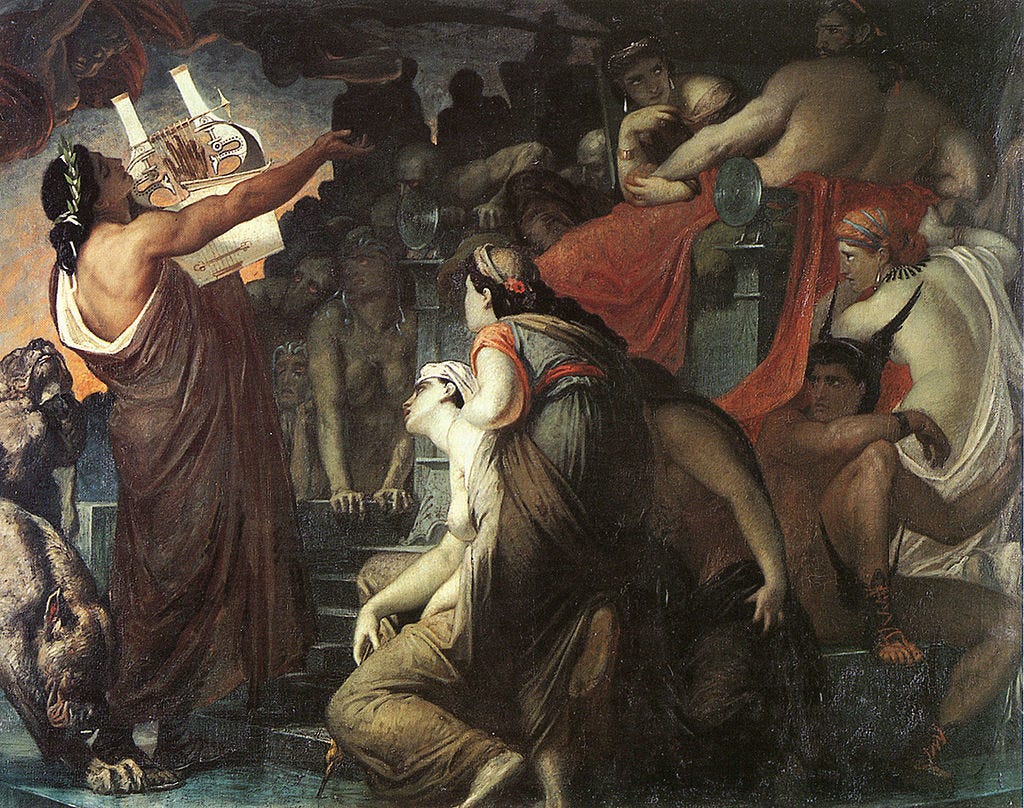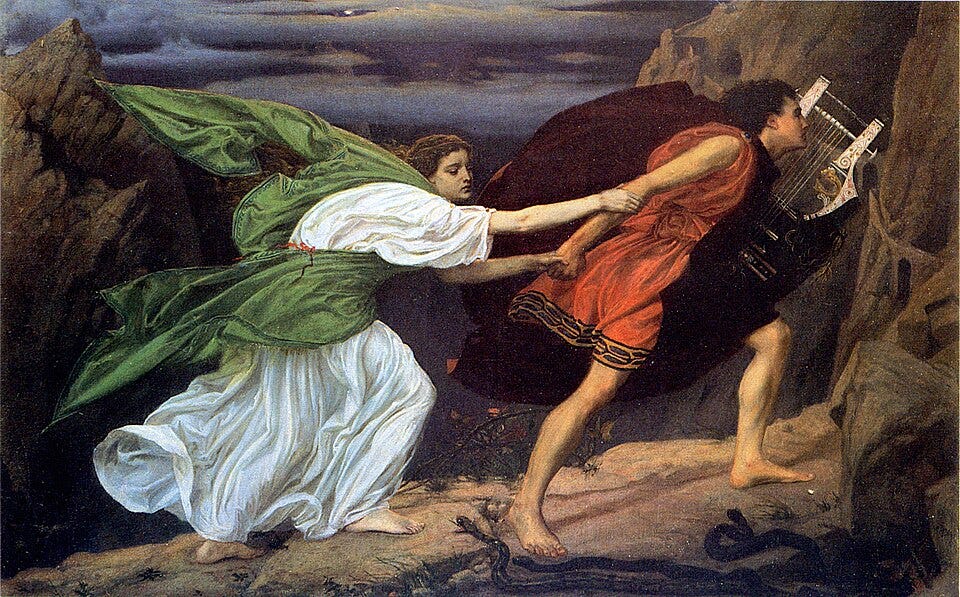Bringing Up Eurydice
All that I see
—Glaukon
I
The great genius of Plato’s allegory of the cave is that he made of the mind a place to dwell within.
Socrates, speaking to Plato’s brother, asks us to imagine a cave wherein people have been chained since childhood and can look only at the images cast on the wall of the cave. They have no knowledge of the world outside the cave, until one of them, having broken free of his chains, turns and walks up into the sunlight, and outside beholds, on the surface, all the real things that had cast their shadows on the wall of the cave.
“And the ascent,” Socrates says to Glaukon, “and the contemplation of the things above is the soul’s ascension to the intelligible region.”1
That “intelligible region” (τὸν νοητὸν τόπον) is contrasted with the realm of sense-perceptions (τὸν ὁρατὸν τόπον). It has been called also “the world of thought” (Jowett) and “the world of understanding” (Desmond Lee). It is the realm of the Forms that makes intelligible their impressions upon us.
In one perfect metaphor Plato figures the mind, its faculties and degrees of consciousness. And it was important that it was not the mind of Heraclitus, whose rushing stream cannot be stepped in the same way twice; nor was it Parmenides’ frozen and eternal abstractions. In Plato, the figure of the mind is a cave, a dwelling place. It is a space one can inhabit, and hence can move within, from the world of shadows to the world of real things, from sense-perceptions to understanding.
"Contemplation is the soul’s ascension to the intelligible realm." One contemplates, and ascends. The word contemplate comes from the word temple, “a space marked out for observation.” To contemplate is to place in the mind the object of one’s attention. The word itself engenders space, interiority, where objects, ideas, emotions, experiences, can be seen, where we can pass from dim knowledge about them, as through a glass darkly, to genuine understanding.
II
The metaphor of the cave did not originate with Plato, though he perfected it. Most likely he borrowed it from the Orphic tradition, with which he would have been familiar.
Orphism, like the cult of Demeter and Persephone, was a religion shrouded in mystery. It involved obscure initiation rites. Some fragments come down to us, hymns, verses, procedures, that hint at a system of values. Some of the earliest Orphic texts we have are gold, funerary papers buried with the dead, instructions on how to avoid the river Lethe and drink from the well of Mnemosyne.
Porphyry quotes a line from Empedocles, a pre-Socratic philosopher and mystic
We have come down under this roofed-in cave
and comments that the words were spoken by the “powers” who conduct the soul into the world.2
Like the Eleusinian Mysteries, Orphism was interested in the descent into the underworld. One of the principle tenets of Orphism seemed to involve purifying oneself in preparation for death.
Plato alludes to these Orphic rituals in the Phaedo when he claims that the man who devotes himself to philosophy “should be cheerful in the face of death, and confident of finding the greatest blessing in the next world when his life is finished.”3 Just as a follower of the Orphic tradition brings instructions with him into the afterlife, so for Plato the pursuit of philosophy prepares one to meet death. Later on in the Phaedo he elaborates by referencing the Orphic rituals explicitly.
The true moral ideal, whether self-control or integrity or courage, is really a kind of purgation from all these emotions [pleasure and pain], and wisdom itself is a sort of purification. Perhaps these people who direct the religious initiations are no so far from the mark, and all the time there has been an allegorical meaning beneath their doctrine that he who enters the next world uninitiated and unenlightened shall lie in the mire, but he who arrives there purified and enlightened shall dwell among the gods. You know how the initiation practitioners say, ‘Many bear the emblems, but the devotees are few’? Well, in my opinion these devotees are simply those who have lived the philosophical life in the right way4
For Plato, the pursuit of wisdom purifies and prepares one for death, for in understanding we are no longer subject to the fear of not knowing. Katabasis, or descent into the underworld, and anabasis, return to the world above, are for Plato key tropes for the soul. And the allegorical meaning he identifies in the Orphic tradition not only prepares one for death, but helps one to live a good life, too. For the soul, in life, having ascended to the intelligible region, “can have its dwelling […] free from the shackles of the body.”
We may read in the allegory of the cave the same Orphic undertones. It is not Plato’s, but Plato makes use of it as a way to figure the activity of the soul as it moves from the realm of sense perceptions to the world of understanding.
III
Orpheus is the poet-musician who journeys into the underworld to rescue Eurydice, his bride. On the day of their marriage, Eurydice accidentally steps into a nest of vipers (in some versions she’s chased by a god) and dies tragically. Orpheus, who is the proto-artist, mourns for her by playing his instrument, and plays so well that all the nymphs and naiads, even the stones and trees, weep for him.
He ventures down to the underworld to rescue her, and there entreats of Hades and Persephone to release her. His music is so moving that Ovid writes how “it made the pale phantoms weep:”
Ixion’s wheel
Was still, Tityos’ vultures left the liver,
Tantalus tried no more to reach for the water,
And Belus’ daughters rested from their urns,
And Sisyphus climbed on his rock to listen.
That was the first time ever in all the world
The Furies wept.5
Hades grants Orpheus’ request, on the condition that he not look back to see Eurydice until after they have left the underworld. Of course, at the last moment, Orpheus looks back, and his wife is lost, again. Her shade dissolves and returns to the depths.
It’s significant that the name Eurydice means something like “broad or profound judgement.” Plato has understood the meaning implicit in the doctrine. The allegory of the cave is that of a man who, moving from the depths of the cave to the world above, has brought with him a sense of profound judgement about the shadows on the wall. Enlightened, he sees things for what they really are.
Significant, too, that the person who makes this journey is Orpheus, the proto-artist. Indeed, the artist is the one who figures the world for us. It is they who have given us the words as we use them, the images and ideas out of which we are conceived. It is they who make intelligible our own experiences to us. What else is the role of the artist if not to strive to figure, with language, music, paint, or moving pictures, what they feel deep down but which has not yet taken shape in the world above? And what were once dim shapes flickering against a wall are seen by the light of the creative impulse for what they really are. And we who witness good art are made to understand.
IV
But Orpheus fails in the end. At the last moment he looks back, and Eurydice is lost. In Plato’s allegory, the man who returns to the cave to tell others what he has seen is condemned and killed. The creative impulse is thwarted, the art misunderstood, misappropriated. What insight is rescued from the depths of the mind anyways never fully captures the reality of things. It is as Nietzsche says: what we have words for is dead in the heart already.
But the role of the artist is not to give men knowledge, as Plato concludes, but to engender in them the capacity for their own soul’s indwelling. What the artist essentially does is figure the imagination. They create the space within for the activity of the soul. Poetry, for example, figures the imagination by means of language, as Paul Ricoeur said, “The poet is that artisan who sustains and shapes imagery using no means other than language.” It is the most important art because it figures the Logos.
Plato, being an artist, uses the Orphic trope of the cave to figure the soul (we would say the mind), and by doing so, makes of it a place in which to dwell. The figure instills interiority and a sense of the soul’s movement from darkness into light. Descending, ascending, the mind coming into understanding. It is an activity that requires a creative impulse, but which everyone possesses the capacity for.
It’s an exquisite metaphor, beautiful not least because of its truth. We feel it to really be the case. One believes that Plato, as with so many of his great metaphors, made the descent into the depths of his imagination to rescue it and bring it up to us. One strives, in one’s own writing, to figure things so well. To represent the thing as it is. Some secret and undisclosed thing made known for all to see.
517b. trans by Paul Shorey
De Antro Nymph, c. 8, from John Burnet’s Early Greek Philosophy
64a. trans by Hugh Tredennick
ibid. 69c-d.
Book X. trans. Rolphe Humphries






J. Tullius introduced me to Wilbur. That's a fun one. And yeah, the cave is an underworld, a place of shadows and shades. Things are trapped or obscured down there. The story of leaving the cave is really the whole metaphor for the mind, both in Plato and in the myth of Orpheus. Katabasis and anabasis.
I so love Philosophy's song about Orpheus in Consolation iii.xii -- the conclusion she draws there for Boethius (facing his brutal death): "To you this tale refers, Who seek to lead your mind Into the upper day; For he who overcome should turn back his gaze Towards the Tartarean cave, Whatever excellence he takes with him He loses when he looks on those below."